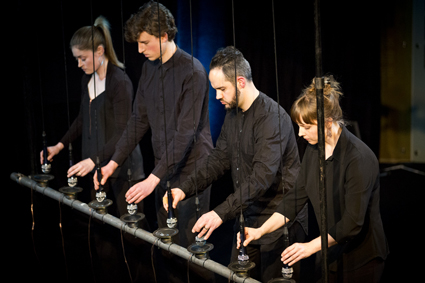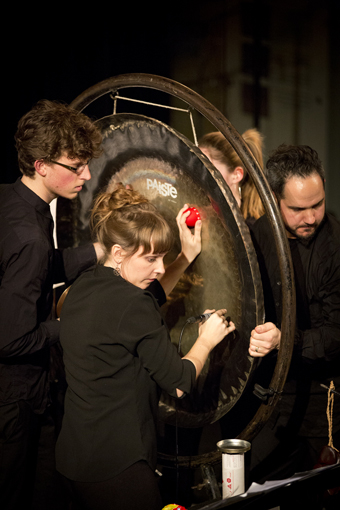A choreography of oscillation
Matthew Lorenzon: Speak Percussion, Robin Fox, Transducer

Transducer, Speak Perecussion, THNMF2013
photo Brad Serls
Transducer, Speak Perecussion, THNMF2013
Tucked away in a wing of the Western Australian Museum, Hackett Hall is a little-known architectural relic. Tiers of empty bookshelves rise up to a painted vault, remnants of almost 70 years of service as part of the State Library. Ornate stone- and metalwork hangs over a vacant interior. Buildings, like musical compositions, can fall silent for centuries, only to return to noisy life under very different circumstances.
One hundred years after the hall’s completion, Speak Percussion, Robin Fox and Byron Scullin bridge the present and the past by juxtaposing the new microphone-based work Transducer with Stockhausen’s Mikrophonie I from almost 50 years ago.
While Mikrophonie I turns the microphone towards a tam-tam (more commonly known as a “gong”), examining its normally inaudible sonic properties “as a doctor ausculates a patient,” Transducer turns the microphone on itself, exploring its materiality and developing ingenious ways of manipulating feedback.
Both pieces demand precise choreography from the microphone-wielding performers. In Mikrophonie I the four performers adoringly stroke and massage the tam-tam. In Transducer the instruments manipulate the performers as their movements are dictated by the physics of oscillation in sound, electricity and the swinging of the pendulum.
At the beginning of Transducer Eugene Ughetti walks onstage and picks up a speaker tied to a common cardioid microphone, a device certain to release a squeal of ear-splitting feedback as the sound received from the microphone is played back to the microphone through the speaker. Swinging the device around his head, Ughetti lengthens the cables until the microphone-speaker describes a circle almost as wide as the stage. Four microphones at the corners of the stage are diffused through eight speakers, placing the audience in the center of a roaring, spinning, pealing vortex.

Mickrophonie I, Transducer, Speak Percussion, THNMF2013
photo Brad Serls
Mickrophonie I, Transducer, Speak Percussion, THNMF2013
The piece progresses through the steady addition, transformation and subtraction of sound sources, giving the performance the air of a geometrical demonstration. Matthias Schack-Arnott, Louise Devenish and Leah Scholes enter and hold up naked speaker cones to Ughetti’s circle, modifying a rhythm of feedback by fanning around the perimeter.
At other times, the four players surround a tall frame of eight microphones hanging above eight speaker cones. The microphones are swung above the speakers, creating phasing rhythms that shift in timbre from ‘whooshing’ sounds to hollow, flute-like tones, their pitch descending as the pendulums slow. The performers must move forward and backwards as they adjust the swing of the pendulums or stop them still over the speakers.
At other times the performers explore the sonic possibilities of the materials comprising the feedback loop. Scholes grabs and shakes the pendulum-microphones tied in a bunch, Schack-Arnott scratches a board fitted with contact microphones, Devenish places small objects in vibrating speaker cones and Ughetti menaces a condenser microphone with a knitting needle, then with a cardioid microphone, grating their mesh housings together. At times the performers explore the magnetic field of a piece of dismantled electronic equipment with two small microphones, producing a range of sounds from mid-range buzzing to slow clicks. When using this instrument, the performers’ gestures are not always met with a change in sound, a possible danger when exploring the limits of electromagnetic interference. This had the fortunate effect of showing the truly experimental nature of the performance, as all experiments must have conditions under which their hypotheses may be proven false. If some gestures are to have truly astonishing effects, others must not.
Perhaps the most remarkable effect is saved until last. Ughetti, in a gesture towards Mikrophonie I, stalks a lone tam-tam with a directional microphone. As he advances, a shimmering peal of feedback fills the room. The tam-tam acts as a filter between a speaker and the microphone, creating a dynamic field of overtones across its surface that are altered as they are explored. As Ughetti moves the microphone towards the tam-tam’s perimeter the rich sound resolves into melodic tones, seemingly singing a minor-mode melody embellished with constantly shifting harmonies that rise up and echo about the empty storeys of the hall.
–
Totally Huge New Music Festival, Transducer, Speak Percussion with Robin Fox, Hackett Hall, The West Australian Museum, Perth, 10 Aug






